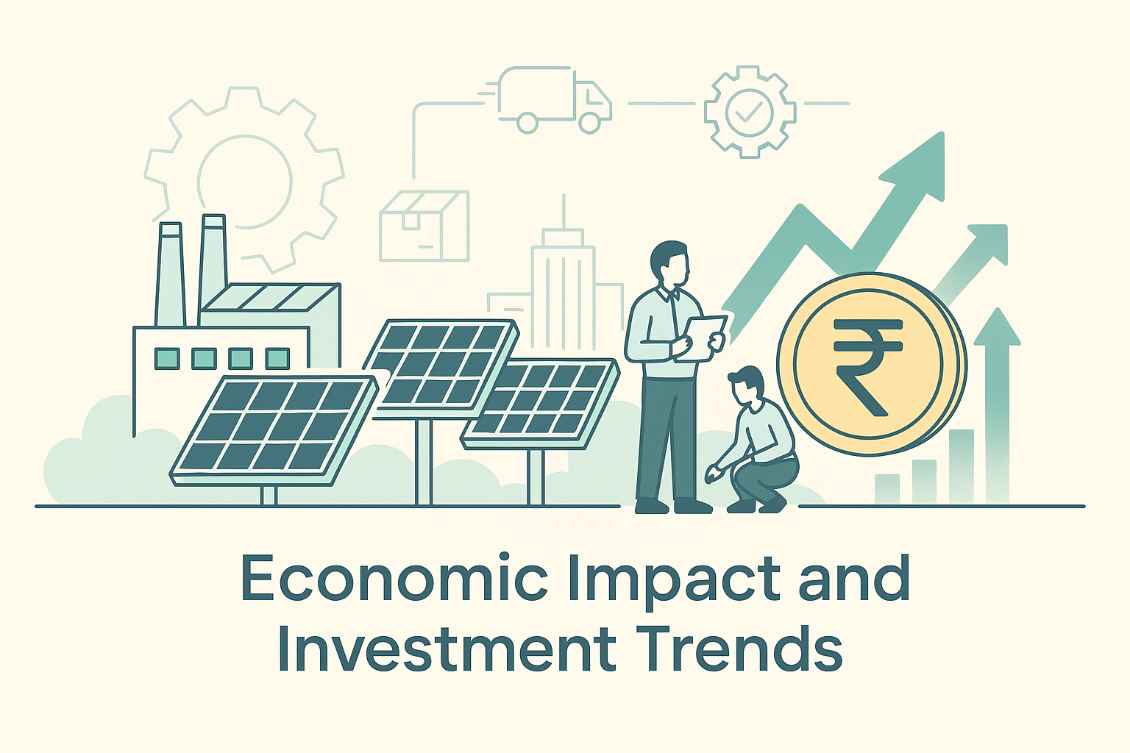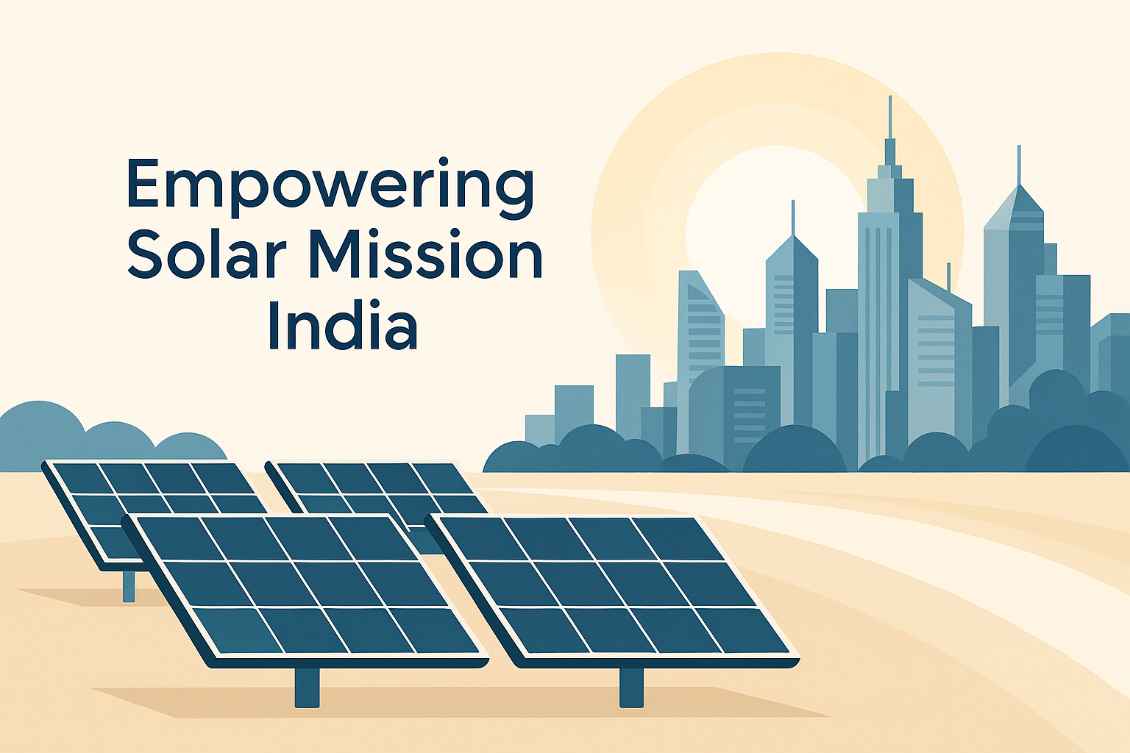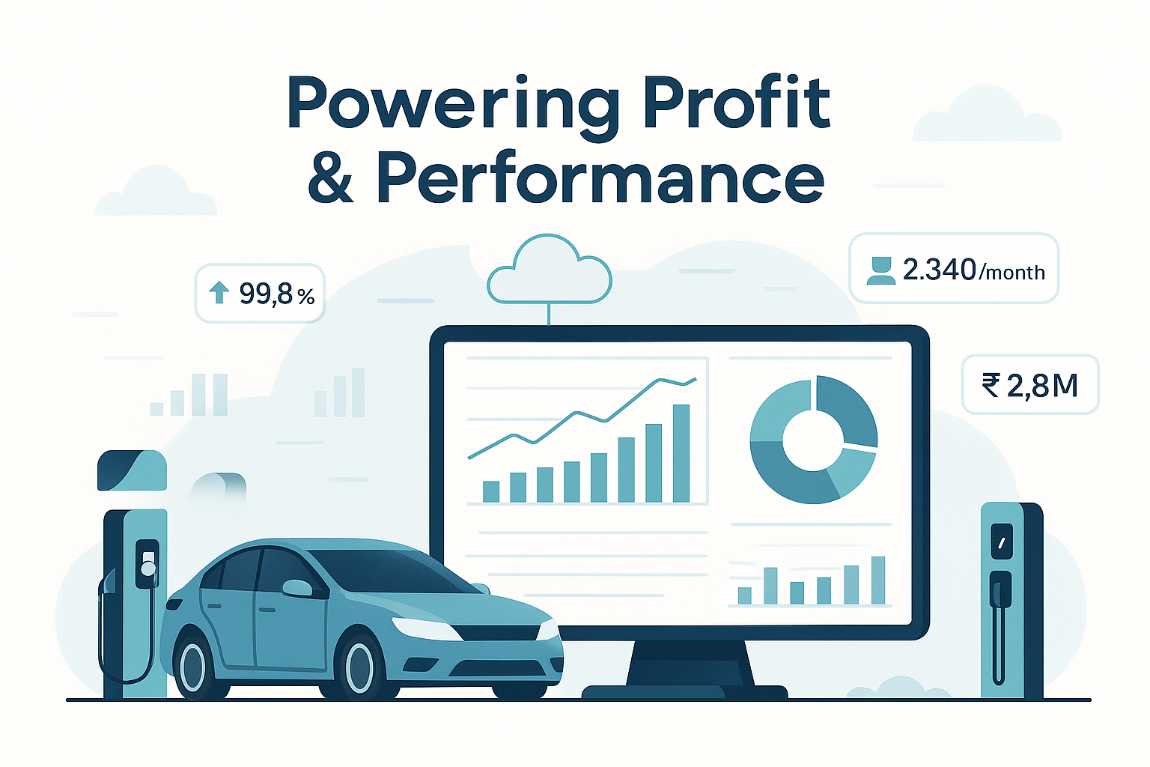Introduction
In today’s dynamic energy sector, solar energy occupies centre stage in India’s renewable revolution. As you explore the Solar Mission India, you witness an ambitious plan that transforms the nation’s energy mix. The initiative emerged to counter the growing demand for sustainable power, reduce environmental impact, and decrease dependency on fossil fuels. Back in 2010, the nation set forth its National Solar Mission, sparking a wave of policy advances and technological investments that continue to shape the market. Today, in 2025, solar energy takes a pivotal role while marked progress in rooftop capacity, government financing and international cooperative efforts sustain a robust momentum. You now see that the problem of conventional energy scarcity and environmental stress has led policymakers to embrace solar energy. The successful evolution of solar technology across India also opens up opportunities for job creation, skill development and economic prosperity. Policymakers and industry experts work hand in hand to implement new methods, update project planning and secure international financing channels. These efforts collectively empower the nation’s vision to achieve energy security and drive economic development.
Throughout this blog post, you will learn about the core aspects of India’s Solar Mission, including policy updates, technological innovations, and strategic investments that shape this vibrant sector. You will also explore real-world examples and data points that underscore the mission’s success and challenges. This comprehensive narrative guides you through the journey of solar energy in India. It provides insights that make it clear how the mission is igniting widespread transformation in the renewable energy landscape. The mission’s strategic framework, policy amendments and futuristic outlook highlight the pathway towards a cleaner, more sustainable energy ecosystem. Get ready to dive into an engaging exploration that resonates with the energy trends of 2025.
Overview of India's Solar Mission
India’s Solar Mission continues to evolve, driven by progressive government policies and a growing appetite for renewable sources of energy. As you read further, you discover how strategic planning has laid a solid foundation for sustainable power generation. The mission underwent several phases. Early on, the initiative focused on boosting solar installations through incentives, and lately, it adopts a more holistic approach, combining policy, technology, and finance. A notable example comes from initiatives launched in Phase I and Phase II, where early policy mandates targeted building rooftop solar capacity in urban areas. Today, comparing past and current efforts highlights the accelerated pace of implementation. Investors and stakeholders have embraced these changes, seeing impressive returns from public-private partnerships.
It is common to list the mission’s integral pillars:
• Policy reforms that streamline project approvals
• Research and development in high-efficiency solar panels
• Financial incentives that spark both local and international investment
You observe that this structured approach not only opens up the market to new technologies but also helps mitigate risks for investors. For instance, recent data show that innovative policies increased rooftop solar capacity significantly in metropolitan areas by over 40% since 2020. Additionally, government benchmarks have been recalibrated to meet future energy needs, ensuring that the solar industry maintains a competitive edge in a swiftly evolving market. With clear milestones, Solar Mission India emerges as a roadmap for harnessing clean energy and reducing India’s carbon footprint.
For broader perspective, India is also on track to achieve its renewable energy target of 2030, reinforcing the alignment between long-term goals and current solar growth.
Strategic Policies Driving Solar Growth
You notice that carefully crafted government solar schemes have boosted solar energy deployment in India. India's National Solar Mission lays out detailed guidelines that help streamline project approvals, reduce bureaucratic hurdles and attract financial backing. Active policy dialogues have led to groundbreaking reforms that support comprehensive solar energy documentation. The current framework encourages the adoption of tools such as solar parks and feed-in tariff models that attract both private and government funding.
The government actively supports initiatives by offering tax incentives, low-interest loans and streamlined permitting processes. Recent reports indicate that policies backed by $16 million international financing approvals have enabled advanced project setups. You also learn that local production incentives lower costs and foster local job creation, creating benefits that ripple through the economy. Such measured steps have built investor confidence across the board, from rural installations to urban rooftop panels.
To illustrate your understanding, consider this simple table comparing key policy phases:
By reducing market uncertainties and fostering a conducive investment environment, these policies support high growth rates. You appreciate that not only do these reforms set the stage for a cleaner future, but they actively drive economic opportunities. As domestic and international investors enter the market, India strengthens its position as a global leader in transitioning to renewable energy. A good example is the Modi Solar Scheme, which empowers households with rooftop installations and subsidy benefits.
Technological Innovations in Solar Energy
You witness how technology transforms the Solar Mission India into a modern marvel. This mission relies on technological breakthroughs that push efficiency, durability and performance standards to new heights. From advanced solar cell manufacturing to digital grid integration, the technological landscape has significantly evolved. Recent innovations power smart solar panels that automatically adjust tilt based on sunlight intensity. As a result, efficiency gains of 20% or more have been common across installations.
Innovation emerges in the form of high-efficiency modules and sensor integration systems that monitor performance in real time. You see clear examples in urban areas where software-enabled controls optimise energy yield by balancing usage and storage. With these challenges managed through innovation, the solar sector sets benchmarks in durability and cost-effectiveness.
Several R&D initiatives recently launched enable India to compete with international standards. In fact, thousands of engineers have collaborated on creating solar arrays that offer advanced power conversion efficiencies and improved resilience under extreme weather conditions. A notable technological data point shows that cutting-edge panels have achieved over 25% efficiency in converting sunlight to energy, a remarkable feat compared to earlier models rated at 15-18%.
These innovations not only address the challenges of space and performance but also open avenues for integrating solar energy with battery storage solutions. As microgrids increase in prevalence, you find that technology continues to refine energy management practices across both urban and rural sectors. In this landscape of rapid innovation, solar power in India serves as a case study in how technological progress can secure energy independence and sustainability.
Economic Impact and Investment Trends

You observe that the Solar Mission India significantly influences the country’s economy. Robust investment trends, paired with favourable policy frameworks, stimulate economic growth at multiple levels. Investment in the solar sector boosts manufacturing, research and employment opportunities. The infusion of capital from domestic and global investors has created a vibrant ecosystem that has drawn widespread attention.
You note that recent international financial support, including a $16 million approval for solar projects, confirms market confidence. Regional economic centres have emerged as hubs for manufacturing and technological research. These hubs foster innovation and contribute to regional development. Small and medium-sized enterprises benefit from ecosystem synergies.
The mission’s impact reaches far beyond job creation alone. When you review key trends, you see that these investments bolster local supply chains, reduce energy costs for industries and generate tax revenues that further support community projects. Breakdown of these economic influences can be summarised into three clear areas:
• Manufacturing: Enhanced local production generates high-quality solar panels.
• Job Creation: Increased installations drive employment in technical and support roles.
• Economic Stability: Reduced energy costs and increased exports support broader economic growth.
By setting realistic targets and ensuring market stability, the Solar Mission India shapes investment trends favourably. The intersection of progressive policies and technological innovation creates an environment where the economy benefits from cleaner, more affordable energy. It becomes evident that every rupee invested contributes to a cycle of growth and reinvention, reinforcing confidence in renewable energy projects. The Free Solar Panel Scheme of 2025 is a prime example of subsidy-driven adoption boosting both investments and grassroots participation.
Future Prospects and Policy Updates
Looking ahead, you understand that the Solar Mission India remains a catalyst for future growth. The vision for 2025 spotlights a vibrant future supported by continuous policy reviews and innovative technology adoption. Forward-thinking regulatory frameworks underpin an unprecedented expansion in solar energy capacity.
Strategic plan updates ensure that technological disruptions are managed and that market volatility continues to be minimised. As you progress through the mission’s trajectory, new policy elements come into play. Enhanced grid integration mechanisms, second-generation solar panels, and flexible financing models are critical focal points. Policy updates aim to streamline procedures, boost local technical expertise and ensure that solar installations comply with rigorous safety and quality standards.
In parallel, new trade discussions address concerns such as pricing strategies and competition for high-performance solar modules. Recent policy debates have acknowledged trade disputes and launched frameworks for international cooperation while maintaining a focus on domestic growth. A data point underscoring this progress shows that the projected installation capacity in 2025 is set to double that of 2020. Such figures highlight robust planning and effective execution.
You can also identify milestones like accelerated deployment in rural areas and urban integration projects that modernise traditional energy grids. This outlook ensures that every new policy decision not only fosters market confidence but also enhances the social and economic benefits of solar energy in India.
Challenges and Solutions in the Solar Sector
Despite triumphs and progressive strides, you recognise that the Solar Mission India faces its share of challenges. These issues include grid integration, power storage, regulatory delays, and localised technical obstacles. The sector must address technical inefficiencies and bridge the gap between rapid expansion and enduring stability.
As you navigate these challenges, you find that solutions emerge from continued research and collaborative industry efforts. One prominent challenge involves ensuring a steady supply of high-efficiency solar components. You see that supply chain disruptions and fluctuating raw material costs risk delaying project timelines. Another major challenge is the need for advanced storage solutions to manage intermittent power generation.
Government agencies and private partners promptly address these hurdles by investing in battery technologies and digital systems to optimise grid stability. To better understand the challenge-response approach, consider these key solutions:
• Investment in R&D to develop durable and efficient solar cells
• Collaborative initiatives between government bodies and private enterprises
• Upgrading grid infrastructure with smart and resilient technologies
For example, recent updates have introduced guidelines that speed up project approvals and promote innovative financing models. By aligning industry best practices with policy imperatives, the government aims to neutralise challenges while paving the way for sustained growth. You appreciate that ongoing dialogues within the industry create an atmosphere of continuous improvement and preparedness for future challenges.
Conclusion
In wrapping up your exploration, the Solar Mission India stands as a beacon of innovative energy policy and technological progress. The mission not only reshapes how energy is sourced and consumed, but it also offers solutions that are both economically and environmentally sustainable.
By embracing cutting-edge technology and progressive regulatory frameworks, India positions itself as a global leader in renewable energy. Reflecting on the journey, you observe that strategic policies and robust investments drive a transformation in local manufacturing, job creation and regional economic stability. Future policy updates promise to further enhance grid integration and storage technologies while tackling emerging challenges.
The lessons learned over the past phases underline the importance of collaboration, innovation and smart planning. You recognize that the road ahead may pose technical and supply chain challenges; however, active industry collaborations and constant policy evolution will steer the sector towards success.
This comprehensive review leaves you with a clear understanding of how the Solar Mission India both shapes and drives the country's energy future. Embrace this dynamic journey as the mission continues to set benchmarks that inspire other nations to follow suit in the push for a sustainable energy ecosystem.
FAQ
• What is the significance of the PSLV C57 launch in India's solar observation goals?
It underlines India's commitment to advancing solar observation, using state-of-the-art launch technology to gather data essential for optimising solar energy performance.
• How do India's solar policies under the National Solar Mission promote the use of solar energy?
They streamline project approvals, offer tax incentives, secure international financing, and back initiatives that boost both rooftop installations and local manufacturing.
• Who is Nigar Shaji and what is her role in the Aditya-L1 project?
Nigar Shaji is a prominent scientist who coordinates research for the Aditya-L1 mission, contributing to the development of instruments that capture critical solar data.
• How does the Aditya-L1 mission observe the Sun?
It deploys advanced instruments to monitor the Sun’s corona and magnetic fields, thereby providing real-time data that influence solar energy strategies.
• What is the objective of India's National Solar Mission (NSM)?
The mission aims to increase solar energy’s share in the national energy mix, reducing fossil fuel dependency while promoting sustainability, job creation, and economic growth.








